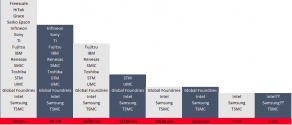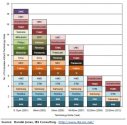You are using an out of date browser. It may not display this or other websites correctly.
You should upgrade or use an alternative browser.
You should upgrade or use an alternative browser.
Chinese semiconductor industry
- Thread starter Hendrik_2000
- Start date
- Status
- Not open for further replies.
Back then you had way more designers with their own fabs like AMD with global foundry. Now everybody and their mother is buying fab capacity at TSMC its a duopoly pretty much with TSMC and Samsung.You must not be aware of this, but Chinese semi companies have been under various types of sanctions since the 90s. Not only did the Chinese companies not make relative progress, they made relative regression since. SMIC was actually competitive 20 years ago with the likes of TSMC, but look how many generations behind it is today. I would say those sanction have had their intended effect. Have you seen how staggering China's trade deficit is in the semiconductor sector? China is well short of its goal of covering 40% of its semiconductor needs by 2020 and has little hope of reaching the target of 70% by 2025.
The question is: who will produce these Huawei's world first 3nm in year 2021? TSMC wont, does Samsung has 3nm capability and capacity? even so, it will still use ASML Lithography (contain US technology). Anyone has an idea?
Huawei is basically betting that the sanctions will come down in time to manufacture those chips. It takes over a year to design a chip. If they are correct then they would be able to quickly ramp up production once the sanctions come down.
D
Deleted member 15949
Guest
-ish. Depends on if the law is written using de minimis or FDPR jurisdictions and even then, it would be dependent on if the EDA was "US-origin".OMG. Stop being such a crybaby.
Export license control is not a propaganda. Any technology/product that was designed/manufactured in the US, or manufactured outside the US but contains a defined percentage of US origin components is legally subjected to export license control, or manufactured/designed outside the US but through the use of defined US technology. Breach the rules and your company risks paying punitive damages or even having your business shut down, not to mention you might be found criminally liable.
D
Deleted member 15949
Guest
US policy was always shipments to China allow for 2 gen behindHow can that be true if China used to be sanctioned even more in the past when they couldn't even buy equipment to work on 300mm wafers? 20 years back China had even more sanctions.
D
Deleted member 15949
Guest
Not really. Even there weren't sanctions, you'd be fighting against firm incumbency and even in non-controlled older nodes, those scale effects dno't exist in ChinaYou must not be aware of this, but Chinese semi companies have been under various types of sanctions since the 90s. Not only did the Chinese companies not make relative progress, they made relative regression since. SMIC was actually competitive 20 years ago with the likes of TSMC, but look how many generations behind it is today. I would say those sanction have had their intended effect. Have you seen how staggering China's trade deficit is in the semiconductor sector? China is well short of its goal of covering 40% of its semiconductor needs by 2020 and has little hope of reaching the target of 70% by 2025.
Usage of domestic EDA tools is critical for national security. There is always the possibility that you might be hardcoding a back door/kill switch/information leakage hardware trojan into your chip by using US origin EDA tools.
Bit late now I guess they've been selling it to China for years and they've been using it for years! With all those backdoors those pesky Chinese must have got something really great in the works, otherwise why ban it, just keep selling it to them, it will be like watching monkeys hitting an atomic bomb with hammers, just take the money and laugh......
Anyway the USA would never do that, its tantamount to IP theft and everyone knows the USA is a staunch believer in IP rights protection, I've watch countless speeches by the American great and good extoling the virtues of it, not sure why you are implying otherwise.
OMG. Stop being such a crybaby.
Export license control is not a propaganda. Any technology/product that was designed/manufactured in the US, or manufactured outside the US but contains a defined percentage of US origin components is legally subjected to export license control, or manufactured/designed outside the US but through the use of defined US technology. Breach the rules and your company risks paying punitive damages or even having your business shut down, not to mention you might be found criminally liable.
Boo Hoo Boo Hoo......
Comprehension of the English language obviously not a strong suit! But I guess to some legality is in the eye of the beholder, however, if I've already bought something is it illegal to use it? If it is I suppose the Chinese could just retroactively make it 'illegal' to use Chinese rare earths in US radars, would solve a big problem! Maybe not!
Back then the sanctions were not entirely watertight and SMIC was very successful at industrial espionage.How can that be true if China used to be sanctioned even more in the past when they couldn't even buy equipment to work on 300mm wafers? 20 years back China had even more sanctions.
SMIC stole TSMC technology and lost the court case:
December 2003, TSMC filed suit alleging systematic intellectual-property (IP) theft and patent infringement by SMIC. Witness testimony indicated:
- An estimated 90% of SMIC’s 180nm logic process was copied from TSMC
- SMIC attempted to disguise the origin of the information by internally referring to TSMC and its technology by the code name ‘BKM1′, referring to ‘Best Known Method 1
- SMIC’s use of TSMC technologies was ‘no secret’ and was openly discussed by SMIC engineers
SMIC dodges US government restrictions:
SMIC can get away with flaunting the U.S. controls because the approved quarter-micron equipment already installed is also capable of making 180nm node chips as well. This has been amply proven by virtually all global fabs that blitzed to 180nm in the last several years using existing production gear.
A critical link to make this possible is using phase shift photomasks to extend installed lithography tools to shrink chips to the new lower line geometries. SMIC claimed the foundry has its own photomask making ability and doesn't rely on U.S., or other foreign sources that would be subject to export controls.
That isn't the whole story, however. SMIC's own photomask capability depends on very sophisticated equipment to pattern the masks to 130nm lines. That gear had to come from foreign suppliers, whose governments apparently sanctioned the sale to SMIC. With the end of Cold War international controls a decade ago, nations are largely free to make their own technology export decisions, subject to whatever pressure the U.S. can bring to bear.
Look at this chart. You can see also how many players dropped out due to the increasing financial burden of staying at the leading edge. 90nm was circa 2002-2003. Source:

This chart is less flattering to SMIC, and is likely more accurate. Let's not forget that TSMC also sued SMIC for copying their 130nm manufacturing technology and 90nm as well.

Last edited:
Sure. But TSMC introduced 180 nm process in 1998.
SMIC was several years behind that.
The introduction of FinFET at 14nm was a major obstacle for a lot of companies and quite a lot simply dropped out of the market. SMIC managed to go past that. Machine tools cost also grew substantially and cost per transistor actually went up instead of down as usual. So yes to go further will require huge amounts of capital which most of the companies formerly in the market can't get.
With regards to TSMC vs SMIC lawsuit, there have also been lawsuits against UMC and Samsung. But for whatever reason it is only SMIC which poaches talent and trade secrets in the US's eyes...
SMIC was several years behind that.
The introduction of FinFET at 14nm was a major obstacle for a lot of companies and quite a lot simply dropped out of the market. SMIC managed to go past that. Machine tools cost also grew substantially and cost per transistor actually went up instead of down as usual. So yes to go further will require huge amounts of capital which most of the companies formerly in the market can't get.
With regards to TSMC vs SMIC lawsuit, there have also been lawsuits against UMC and Samsung. But for whatever reason it is only SMIC which poaches talent and trade secrets in the US's eyes...
And to that point, *a lot* of companies fell behind TSMC and Samsung, some of whom used to lead those two, if they didn’t drop out of the market entirely. We shouldn’t trivialize what it takes to keep up with these intense ever more expensive and more difficult two year cycles. That SMIC is still in the game is a testament to success.Sure. But TSMC introduced 180 nm process in 1998.
SMIC was several years behind that.
The introduction of FinFET at 14nm was a major obstacle for a lot of companies and quite a lot simply dropped out of the market. SMIC managed to go past that. Machine tools cost also grew substantially and cost per transistor actually went up instead of down as usual. So yes to go further will require huge amounts of capital which most of the companies formerly in the market can't get.
With regards to TSMC vs SMIC lawsuit, there have also been lawsuits against UMC and Samsung. But for whatever reason it is only SMIC which poaches talent and trade secrets in the US's eyes...
- Status
- Not open for further replies.
